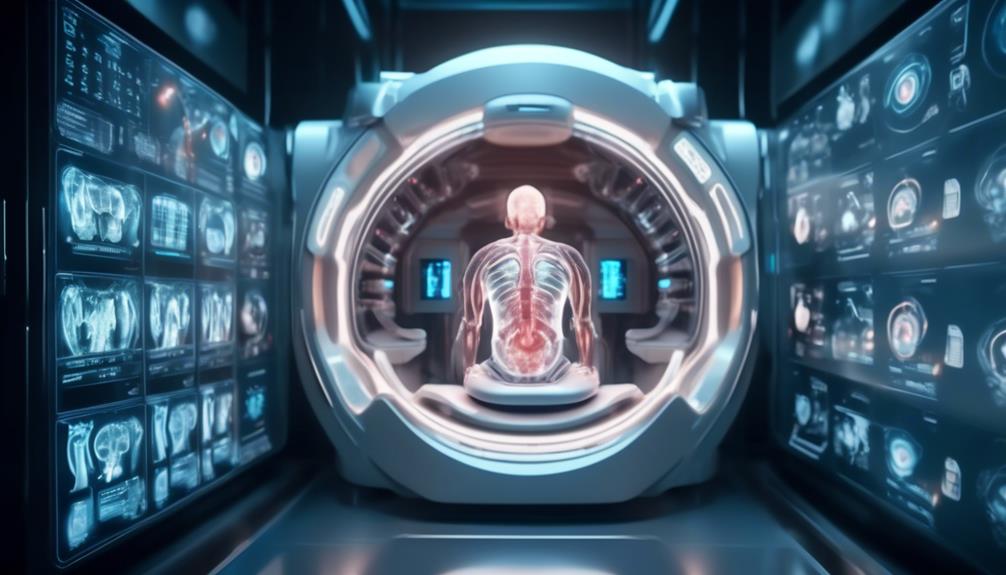Have you ever pondered the profound impact that advancements in medical imaging data have had on modern healthcare practices? From the intricate details captured in radiology reports to the revolutionary capabilities of MRI and CT scans, the realm of medical imaging data is constantly evolving with innovative technologies. But what are the top 12 innovations driving this transformative field forward, and how are they reshaping the landscape of medical diagnostics and patient care?
Radiology Reports
In modern medical practice, radiology reports serve as crucial diagnostic tools, providing detailed interpretations of imaging findings to guide patient care. With advancements in radiology technology, the landscape of medical imaging has evolved significantly. One of the notable imaging trends is the integration of artificial intelligence (AI) in radiology reports. AI algorithms can assist radiologists in analyzing images more efficiently, leading to faster and more accurate diagnoses. This technology can help in identifying patterns, anomalies, and even predicting potential outcomes based on imaging data.
Moreover, there has been a shift towards structured reporting in radiology, where standardized templates are used to ensure consistent and comprehensive documentation of findings. This approach not only enhances communication between healthcare providers but also facilitates data mining and analysis for research purposes. Additionally, the adoption of cloud-based solutions for storing and sharing radiology reports has enabled seamless access to imaging data across different healthcare settings, improving collaboration and patient care. Overall, these innovations in radiology reports are revolutionizing the field of medical imaging, making diagnoses more precise and patient care more efficient.
MRI Scans
Utilizing magnetic resonance imaging (MRI) technology allows for intricate visualization of internal structures within the body, aiding in comprehensive diagnostic assessments. MRI technology has seen remarkable advancements in recent years, particularly in enhancing image quality. The evolution of MRI machines with higher magnetic field strengths has significantly improved the resolution and clarity of images produced. These advancements reduce image noise, provide better tissue contrast, and enhance overall diagnostic accuracy.
Moreover, innovations in MRI technology have led to the development of techniques such as diffusion-weighted imaging (DWI) and magnetic resonance spectroscopy (MRS), which offer additional insights into tissue characteristics and function. DWI enables the assessment of tissue cellularity and can aid in the early detection of strokes, while MRS provides information about tissue metabolism and can assist in tumor characterization.
CT Scans
CT scans have revolutionized medical imaging through their ability to provide detailed cross-sectional images of the body. Recent advancements in CT scan technology have significantly improved image quality and reduced radiation exposure for patients. The benefits of enhanced imaging and improved diagnostic accuracy make CT scans an invaluable tool in modern healthcare.
CT Scan Technology
By combining advanced imaging technology with intricate data processing algorithms, medical professionals can obtain highly detailed cross-sectional images of the human body through the use of CT scans. CT scan technology continues to evolve, enhancing diagnostic capabilities and patient care.
Key Aspects of CT Scan Technology:
- Improved Radiation Safety: Ongoing advancements in imaging technology aim to reduce radiation exposure during CT scans, prioritizing patient safety.
- Enhanced Contrast Agents: The utilization of cutting-edge contrast agents in CT scans plays a crucial role in improving diagnostic accuracy, allowing for better visualization of anatomical structures and abnormalities.
- Enhanced Diagnostic Accuracy: Through refinements in data processing algorithms, CT scan technology can provide more precise and reliable diagnostic information, aiding in the detection and characterization of various medical conditions.
Advancements in Imaging
Advancements in medical imaging have revolutionized the field of diagnostics, particularly in the realm of CT scans. Remote monitoring and telemedicine capabilities now allow healthcare professionals to access and interpret CT scan results from anywhere, facilitating faster diagnosis and treatment decisions. Wearable devices equipped with imaging technology enable continuous monitoring of patients, providing real-time data for immediate analysis. Virtual reality applications enhance the visualization of CT scan images, offering detailed 3D representations that aid in surgical planning and medical education. These innovative tools not only improve the efficiency of CT scan procedures but also enhance patient care by enabling more precise and timely interventions based on the imaging data.
Diagnostic Accuracy Benefits
Enhancing diagnostic accuracy in medical imaging, particularly through the utilization of advanced CT scan technology, brings significant benefits to the field of diagnostics. CT scans offer unparalleled precision and detail, aiding in the early detection and accurate diagnosis of various medical conditions.
Key Benefits of Advanced CT Imaging Technology:
- Improved Resolution: Advanced CT scans provide high-resolution images, allowing for better visualization of anatomical structures and abnormalities.
- Enhanced Contrast: The use of contrast agents in CT imaging enhances the visibility of blood vessels, tumors, and other critical structures.
- 3D Reconstruction: Advanced CT technology enables the creation of detailed 3D reconstructions, aiding in surgical planning and treatment decisions based on precise anatomical information.
Ultrasound Images
Ultrasound imaging has seen remarkable advancements, particularly in the improved clarity of images. The development of 3D ultrasound technology has revolutionized medical imaging, allowing for more detailed and comprehensive visualization of anatomical structures. These innovations in ultrasound images offer healthcare professionals a more precise and accurate tool for diagnosis and treatment planning.
Improved Clarity in Ultrasounds
With advancements in signal processing algorithms, medical imaging researchers have been able to enhance the clarity of ultrasound images significantly. These improvements are crucial for better diagnostic accuracy and precision in medical settings. Here are three key advancements contributing to the enhanced clarity in ultrasounds:
- Advanced Beamforming Techniques: Utilizing advanced beamforming algorithms helps in focusing ultrasound beams more precisely, resulting in improved resolution and reduced artifacts.
- Multi-Frequency Imaging: By employing multiple frequencies during ultrasound scanning, practitioners can obtain images with enhanced contrast and detail, leading to better visualization of tissues and structures.
- Deep Learning-Based Image Enhancement: Leveraging deep learning algorithms for image enhancement can help in reducing noise and enhancing details in ultrasound images, ultimately improving overall clarity and diagnostic quality.
Advancements in 3D Imaging
Building upon the advancements in clarity achieved in ultrasound imaging, the progression into 3D imaging technology marks a significant leap in the visualization capabilities of medical practitioners. Through the integration of sophisticated 3D rendering techniques, ultrasound imaging now offers volumetric data representation, enabling a more comprehensive understanding of anatomical structures. Imaging software advancements have played a pivotal role in the enhancement of 3D ultrasound images, allowing for detailed examinations with improved accuracy and depth perception. These innovations empower healthcare professionals to conduct intricate assessments, leading to more precise diagnoses and treatment plans. By harnessing the capabilities of 3D imaging in ultrasound technology, medical practitioners can delve deeper into the intricacies of the human body, revolutionizing the field of medical imaging.
Digital Format
Utilizing advanced software algorithms, converting medical imaging data into a digital format allows for enhanced analysis and storage capabilities. This transformation enables healthcare providers to harness the power of data analytics for improved patient care and diagnosis accuracy. Here are three key benefits of digitizing medical imaging data:
- Efficient Digital Storage: Storing medical imaging data in a digital format eliminates the need for physical film or printed images, reducing storage space requirements and enabling easy access to patient records. Digital storage also ensures data integrity and security, protecting sensitive information.
- Enhanced Data Analytics: Digital medical imaging data can be easily integrated with artificial intelligence (AI) algorithms for in-depth analysis. This integration enables healthcare professionals to leverage AI-driven tools for faster image interpretation, early disease detection, and personalized treatment planning.
- Streamlined Workflow: By digitizing medical imaging data, healthcare facilities can streamline their workflows, leading to quicker diagnosis, treatment, and patient outcomes. Digital formats allow for seamless sharing of images between healthcare providers, improving collaboration and decision-making processes.
Image Analysis
When analyzing medical images, AI plays a crucial role in enhancing precision and accuracy. AI algorithms can assist in detecting subtle abnormalities that might be overlooked by the human eye. These advancements in image analysis can lead to more reliable diagnostic outcomes and improved patient care.
AI in Image Analysis
In the realm of medical imaging data, artificial intelligence plays a pivotal role in revolutionizing image analysis through its advanced algorithms and machine learning capabilities. When it comes to AI applications in image analysis, the following key aspects stand out:
- Automated Diagnosis: AI models trained on vast datasets can accurately detect and classify abnormalities in medical images, aiding radiologists in making quicker and more precise diagnoses.
- Enhanced Image Segmentation: Machine learning algorithms enable precise delineation of structures within medical images, crucial for treatment planning and monitoring disease progression.
- Personalized Treatment Plans: AI analyzes imaging data to predict patient outcomes, helping clinicians tailor treatment strategies based on individual characteristics identified in the images.
AI-driven image analysis is transforming healthcare by improving diagnostic accuracy and treatment efficacy.
Precision and Accuracy
AI-driven image analysis not only enhances diagnostic accuracy and treatment efficacy in medical imaging data but also focuses on achieving precision and accuracy through advanced algorithms and machine learning capabilities. Machine learning applications play a crucial role in improving the accuracy of image analysis by enabling algorithms to learn patterns and make predictions based on large datasets. These algorithms can detect subtle changes in medical images that might be missed by the human eye, leading to more accurate diagnoses and treatment planning. By increasing precision, machine learning applications contribute to better clinical outcomes by assisting healthcare providers in making informed decisions and providing personalized care to patients based on the analysis of medical imaging data.
Image Interpretation
Utilizing advanced algorithms and pattern recognition techniques, medical professionals can efficiently analyze and derive meaningful insights from complex medical imaging data for accurate diagnosis and treatment planning. Image interpretation has been significantly enhanced through the implementation of deep learning models and image recognition technologies.
Key Aspects of Image Interpretation:
- Deep Learning Algorithms:
- Deep learning algorithms, such as convolutional neural networks (CNNs), have revolutionized image interpretation by enabling automated feature extraction and classification of medical images.
- Enhanced Accuracy:
- By leveraging deep learning techniques, medical imaging systems can achieve higher levels of accuracy in detecting abnormalities or identifying specific anatomical structures.
- Real-Time Decision Support:
- Image interpretation powered by deep learning facilitates real-time decision support for radiologists, aiding in prompt diagnosis and treatment decisions based on the extracted insights from medical images.
Data Storage
With the advancements in image interpretation through deep learning algorithms, the efficient storage of massive volumes of medical imaging data becomes paramount for maintaining accessibility and integrity in healthcare systems. Cloud integration plays a crucial role in modern data storage solutions for medical imaging. By utilizing cloud services, healthcare providers can securely store vast amounts of data off-site, ensuring scalability, accessibility, and disaster recovery capabilities. Cloud integration also allows for seamless collaboration among healthcare professionals, enabling real-time access to critical medical imaging data from various locations.
Data encryption is another essential component of secure medical imaging data storage. Encrypting data at rest and in transit helps safeguard patient information and ensures compliance with data protection regulations. Implementing robust encryption methods adds an extra layer of security to prevent unauthorized access to sensitive medical imaging data.
Data Security
Ensuring the security of medical imaging data is a critical aspect of maintaining patient privacy and compliance with regulatory standards. To achieve robust data security in medical imaging, consider the following key elements:
- Data Encryption: Implementing advanced encryption techniques such as AES (Advanced Encryption Standard) or RSA (Rivest-Shamir-Adleman) can safeguard medical imaging data both in transit and at rest. Encryption converts sensitive information into unreadable code, ensuring that even if unauthorized individuals access the data, they cannot decipher it without the encryption key.
- Access Control: Utilize access control mechanisms to restrict unauthorized users from viewing or modifying medical imaging data. Implement role-based access control (RBAC) to ensure that only authorized personnel can access specific data based on their roles within the healthcare organization.
- Audit Trails: Establish comprehensive audit trails that track all interactions with medical imaging data. Monitoring and logging user activities can help detect any unauthorized access attempts or breaches, enabling prompt mitigation actions to protect patient privacy and data integrity.
Regulatory Compliance
To comply with regulatory standards in medical imaging data management, organizations must establish robust protocols and procedures. Regulatory updates play a crucial role in shaping how medical imaging data is handled, requiring constant vigilance to ensure compliance. Compliance challenges often stem from the evolving nature of regulations, necessitating continuous monitoring and adaptation of policies.
Organizations must stay informed about regulatory updates from governing bodies such as the FDA and HIPAA to align their practices accordingly. Implementing mechanisms to track and integrate these updates into existing protocols is essential for maintaining compliance.
Compliance challenges in medical imaging data management can arise from the complexity of regulations, differing requirements across regions, and the need to balance security with accessibility. Organizations must navigate these challenges by conducting regular audits, providing staff training, and leveraging technology solutions to streamline compliance processes.
Medical Software
Navigating the intricacies of regulatory compliance in medical imaging data management necessitates a deep understanding of the role that medical software plays in ensuring data accuracy and security. medical software serves as the backbone of modern healthcare systems, facilitating essential functions such as medical visualization, machine learning algorithms, data integration, and remote monitoring capabilities.
Key Aspects of Medical Software:
- Medical Visualization: Advanced medical software enables the creation of detailed 2D and 3D visualizations from imaging data, aiding in accurate diagnosis and treatment planning.
- Machine Learning Integration: Incorporating machine learning algorithms into medical software allows for the automation of tasks like image analysis, pattern recognition, and predictive analytics, enhancing diagnostic accuracy and efficiency.
- Data Integration and Remote Monitoring: Medical software plays a crucial role in integrating diverse data sources, enabling seamless access to patient information across healthcare systems. Additionally, remote monitoring functionalities empower healthcare providers to track patient data in real-time, improving care delivery and patient outcomes.
Healthcare Providers
Understanding the pivotal role that healthcare providers play in the effective implementation and utilization of medical software is essential for optimizing patient care and outcomes. Healthcare providers are at the forefront of utilizing healthcare technology to deliver quality care and improve patient outcomes. With the advancements in medical software and data analytics, healthcare providers can now access a wealth of information to make informed decisions and provide personalized treatment plans.
Healthcare technology has revolutionized the way providers deliver care by streamlining processes, enhancing communication, and improving diagnostic accuracy. Data analytics tools assist healthcare providers in interpreting vast amounts of medical imaging data efficiently, leading to quicker diagnoses and more tailored treatment strategies. By leveraging data analytics, healthcare providers can identify trends, predict outcomes, and ultimately enhance patient care.
Frequently Asked Questions
Can Medical Imaging Data Be Used for Research Purposes Beyond Patient Diagnosis and Treatment?
Yes, medical imaging data can be utilized for various research applications beyond patient diagnosis and treatment. Through advanced data analytics, researchers can uncover insights, trends, and patterns that contribute to medical advancements and improved healthcare outcomes.
How Do Advancements in Medical Imaging Data Impact Healthcare Costs for Patients and Providers?
Advancements in medical imaging data, driven by technological innovations, enhance diagnostic accuracy and treatment planning. This precision can lead to streamlined care pathways, reducing unnecessary procedures and hospital stays, ultimately impacting healthcare costs for both patients and providers.
What Measures Are in Place to Ensure the Accuracy and Reliability of Medical Imaging Data?
Ensuring data accuracy in medical imaging is as crucial as a surgeon’s precision. Quality assurance protocols, rigorous data validation techniques, and constant monitoring are in place to uphold the reliability of imaging data, safeguarding patient care.
Are There Any Ethical Considerations Surrounding the Storage and Use of Medical Imaging Data?
When it comes to ethical considerations in the storage and use of medical imaging data, data privacy is paramount. Ensuring patient information remains confidential and secure is essential to maintaining trust and upholding ethical standards.
How Do Advancements in Medical Imaging Data Affect the Training and Education of Healthcare Professionals in the Field of Radiology?
Advancements in medical imaging data revolutionize radiology training programs, enhancing hands-on learning with cutting-edge technologies. Impact on education is profound, ensuring healthcare professionals receive the most up-to-date skills to provide accurate diagnoses and treatments.




